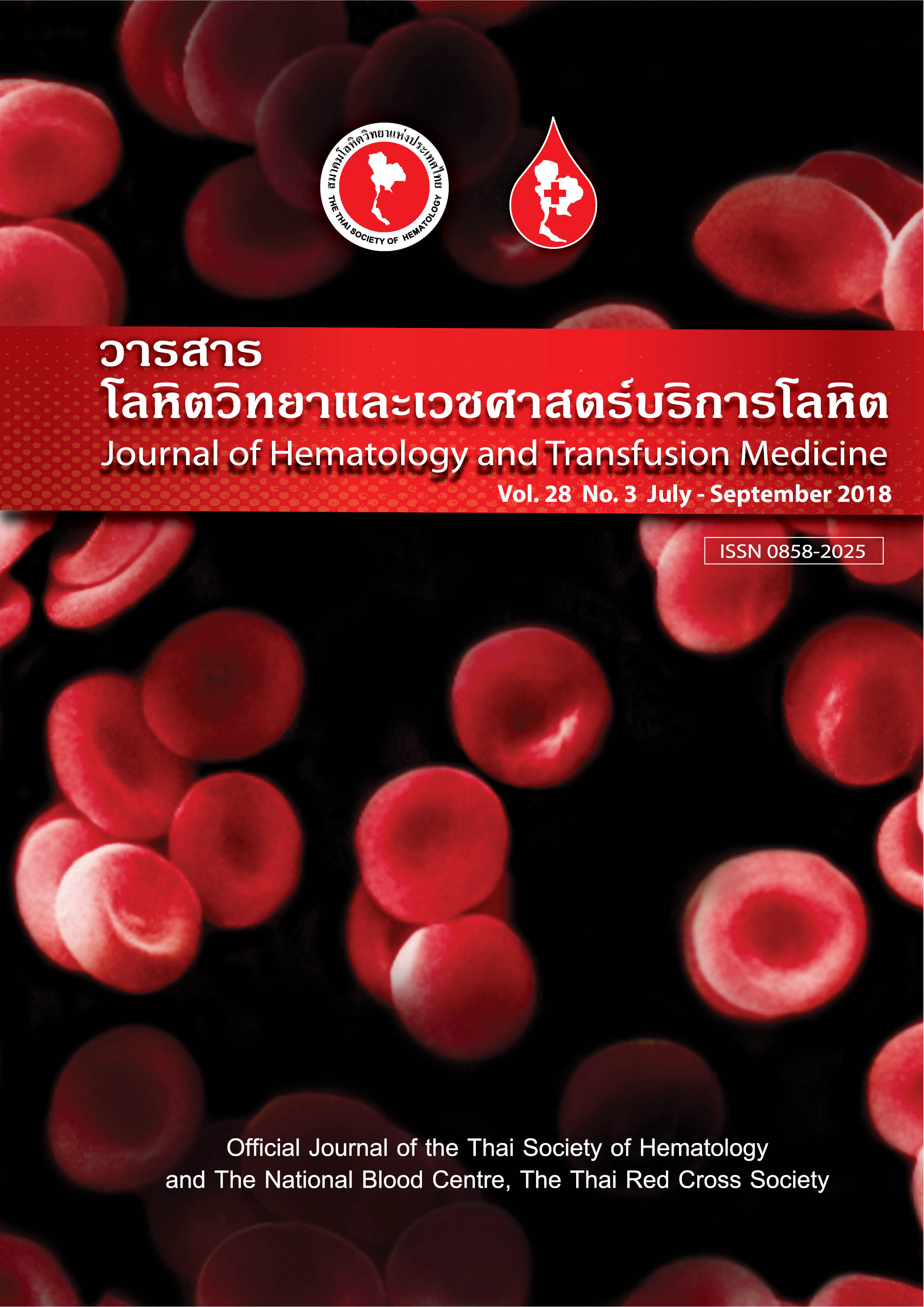The Efficacy of Itraconazole Oral Capsule and Fluconazole as Antifungal Prophylaxis during Neutropenic Episodes in Patients with Acute Myeloid Leukemia
Keywords:
Antifungal prophylaxis, invasive fungal infection, fluconazole, itraconazole, Acute myeloid leukemia, aspergillosisAbstract
Objectives To determine the failure rate of antifungal prophylaxis between itraconazole and fluconazole during neutropenic episodes in patient with acute myeloid leukemia (AML)
Method A retrospective cohort study recruited patients with AML who were treated at Chiang Mai University hospital between January 2004 and May 2014. According to the institute treatment protocol for fungal prophylaxis, those who were treated during the year of 2004-2006, received fluconazole 200 mg/day while patients, treated during 2007-2014, received itraconazole oral capsule 400 mg/day.
Result There were 80 patients, receiving a total of 281 cycles of chemotherapy. Invasive fungal infection (IFI) occurred in 42 neutropenic episodes after chemotherapy, given the prevalence of IFI of 14.9%. Of these, there were possible, probable and proven IFI of 9.2%, 3.2% and 2.8%, respectively. Invasive aspergillosis (90%) was the most common IFI while candidiasis (5%) and fusariosis (5%) were quite uncommon. The prevalence of IFI among patients receiving fluconazole and itraconazole prophylaxis were 20% and 13.6%, respectively (P=.21). Itraconazole was independently reduced the risk of antifungal prophylaxis failure when compared to fluconazole (OR 0.50, 95%CI 0.26-0.95, P=.03). Age over 50 years (HR 2.39, 95%CI 1.15-5.04, P=.02) and unfavorable cytogenetic-risk (HR 2.56, 95%CI 1.34-5.18, P=.01) inversely affected on overall survival (OS). However, types of antifungal prophylaxis did not independently affect OS (HR 0.69, 95%CI 0.32-1.61, P=.38).
Conclusion Itraconazole oral capsule had a better efficacy than fluconazole for prevention of IFI during neutropenic episodes of AML patients. Prospective controlled trial is required to confirm this result.
Downloads
References
2. Freifeld A, Bow E, Sepkowitz K, Boeckh M, Ito J, Mullen C et al. Clinical Practice Guideline for the Use of Antimicrobial Agents in Neutropenic Patients with Cancer: 2010 Update by the Infectious Diseases Society of America. CID 2011;52:e56-e93
3. Slavin MA, Osborne B, Adams R, Levenstein M, Schoch H, Feldman A et al. Efficacy and safety of fluconazole prophylaxis for fungal infections after marrow transplantation–a prospective, randomized, double-blind study. J Infect Dis 1995; 171:1545–52.
4. Rotstein C, Bow EJ, Laverdiere M, Ioannou S, Carr D, Moghaddam N, et al. Randomized placebo controlled trial of fluconazole prophylaxis for neutropenic cancer patients: benefit based on purpose and intensity of cytotoxic therapy. The Canadian Fluconazole Prophylaxis Study Group. Clin Infect Dis 1999; 28:331–40.
5. Marr KA, Crippa F, Leisenring W, Hoyle M, Boeckh M, Balajee M, et al. Itraconazole versus fluconazole for prevention of fungal infections in patients receiving allogeneic stem cell transplants. Blood 2004 103:1527-1533
6. Winston DJ1, Maziarz RT, Chandrasekar PH, Lazarus HM, Goldman M, Blumer JL, et al. Intravenous and oral itraconazole versus intravenous and oral fluconazole for long-term antifungal prophylaxis in allogeneic hematopoietic stem-cell transplant recipients. A multicenter, randomized trial. Ann Intern Med. 2003 May 6;138(9):705-13.
7. Nucci M, Biasoli I, Akiti T, Silveira F, Solza C, Barreiros G, et al. A double-blind, randomized, placebo-controlled trial of itraconazole capsules as antifungal prophylaxis for neutropenic patients. Clin Infect Dis. 2000;30:300–305.
8. Marks DI, Pagliuca A, Kibbler CC, Glasmacher A, Heussel CP, Kantecki M, Miller PJ, Ribaud P, Schlamm HT, Solano C, Cook G; IMPROVIT Study Group. Voriconazole versus itraconazole for antifungal prophylaxis following allogeneic haematopoietic stem cell transplantation. Br J Haematol. 2011;155(3):318–327.
9. Cornely OA, Maertens J, Winston DJ, Perfect J, Ullmann AJ, Walsh TJ et al. Posaconazole vs. fluconazole or itraconazole prophylaxis in patients with neutropenia. N Engl J Med 2007; 356: 348–359.



